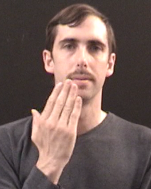ASL words can use vertical space to add shades of meaning. For example, male and female differences are determined by locating hands by the forehead or by the chin. Other words are formed at eye-level to indicate aiming.
The "exact" height at which a word should be formed is seldom met. Most signs are formed around the chest because the elbows are easier to bend and flex than the shoulders are to rotate up. Many forehead-height words end up being formed about eye-level, eye-level words by the chin, and chin-level signs by the shoulders.
In ASL words that use two hands touching each other, this lowering of vertical space causes a problem as to which way is supposed to be "up". With the shoulders rotated up, the forearms stand away from the body in a vertical position. When the shoulders are relaxed, the forearms extend from the chest in a horizontal position.
The ASL word for SUPPORT has the Base Hand S palm-in above the Wide Hand S palm-in. The hands are away from the chin so that the wide hand can touch the bottom of the base hand in an upward movement. The listener can see the vertical separation between the S hands. When the elbows come back in line with the body, the two S hands are facing upward and placed behind / in front of each other.
The directionality of the palms, base hand distance, and wide hand movement all remained consistent with the direction of the forearms, not with the direction of gravity. The ASL word did not change meaning. The shoulder rotation is simply not important to the overall understanding of many ASL words. This reduced shoulder rotation helps the speaker to conserve movement, which is important when using such large muscle groups.
The same kind of direction translation happens with the wrists. The ASL word ONE has the palm facing in to the body and the first finger pointing up. ELEVEN uses the thumb to hold the bent first finger, which the flicks twice indicating two one's in a row. These can be signed palm facing up or even palm facing the side. SISTER used to use GIRL-SAME, where SAME had both palms facing down and the first fingers touching side by side . The new sign still starts with GIRL, but now it leaves the palms facing to the side and touches the right hand down on the left.
Leaving the palms facing to the side reduces the carpal tunnel compression, which far too many people have ignored and caused repetitive stress disorders. I currently use a vertical keyboard because of typing with my palms facing down for too many decades, so I have the greatest empathy for signers who do not want to twist their wrists much.
These examples show that very common ASL words with originally meaningful locations, wrist rotations or vertical spacing may have be dropped lower or use translated directions yet they retain their original concept. They are now less "transparent" as to what they represent as a compromise to be able to say more without overtaxing certain body muscles and joints. Now that's what I call "listening to your body."
Sunday, May 30, 2010
Subscribe to:
Posts (Atom)
